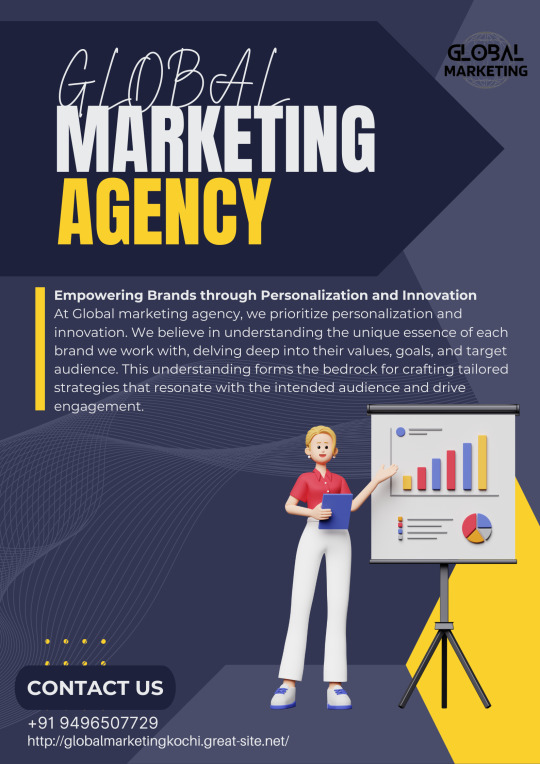Don't wanna be here? Send us removal request.
Text

The digital landscape is a dynamic and ever-changing terrain, and our agency thrives on navigating its intricacies. We understand the importance of staying agile and adapting to emerging trends, algorithms, and consumer behaviors. This agility allows us to tailor our strategies and campaigns accordingly, ensuring our clients remain at the forefront of their industries.
0 notes
Text
The Art and Science of Graphic Design: Transforming Ideas into Visual Stories

Graphic design is a powerful medium that intertwines artistry, technology, and creativity to convey messages, evoke emotions, and captivate audiences. From branding and advertising to user interface design and multimedia presentations, the influence of graphic design is omnipresent in our daily lives. In this blog post, we'll delve into the fascinating world of graphic design, exploring its essence, the creative process, and its significant impact on various aspects of our society.
The Essence of Graphic Design
At its core, graphic design is about effective communication through visual elements. It's a creative process that involves combining typography, imagery, color, layout, and various design principles to create compelling visuals that convey a specific message or idea. Here are some key aspects that define the essence of graphic design:
1. Visual Communication:
Graphic design is a language of visuals. It utilizes images, typography, symbols, and other elements to communicate messages, ideas, and information in a clear and engaging manner.
2. Aesthetic Appeal:
Aesthetics are crucial in graphic design. The visual appeal of a design not only grabs attention but also conveys a sense of professionalism and credibility.
3. Functionality:
Designs must serve a purpose and function effectively for their intended audience. Whether it's a website, a brochure, or a logo, the design should align with its objectives and target audience.
4. Problem Solving:
Graphic designers often face the challenge of presenting complex information in a simplified and visually appealing way. They are problem solvers, finding creative solutions to effectively communicate ideas.
The Creative Process in Graphic Design
The creative process in graphic design involves several stages, each crucial in crafting an exceptional and meaningful design. Here's a simplified breakdown of the typical design process:
1. Understanding the Brief:
Begin by thoroughly understanding the project requirements, target audience, goals, and constraints. The more clarity you have at this stage, the better the outcome.
2. Research and Inspiration:
Conduct research to gather information about the industry, trends, competitors, and design styles. Seek inspiration from various sources to fuel your creativity.
3. Conceptualization:
Generate initial ideas and concepts based on the gathered information. Brainstorm and sketch rough layouts to visualize potential directions for the design.
4. Design Development:
Refine the chosen concept, incorporating feedback and making necessary adjustments. Experiment with color schemes, typography, imagery, and layout to achieve the desired look and feel.
5. Feedback and Revisions:
Share the design with stakeholders or clients for feedback. Revise and iterate based on the feedback received, ensuring the design aligns with the project objectives.
6. Finalization and Delivery:
Once the design is approved, prepare the final files for delivery, ensuring they meet the necessary specifications for the intended use (print, web, etc.).
Impact of Graphic Design in Society
Graphic design has a profound influence on various aspects of our society and everyday life. Here are a few ways it shapes our world:
1. Branding and Marketing:
Strong and memorable branding is a result of effective graphic design. Logos, packaging, advertisements, and marketing materials are all designed to attract customers and convey brand identity.
2. Web and User Experience:
Websites, mobile apps, and online platforms rely heavily on graphic design to provide an intuitive, visually appealing, and seamless user experience.
3. Social and Cultural Impact:
Graphic design often mirrors social and cultural movements, conveying messages about identity, diversity, inclusivity, and societal values.
4. Education and Information:
Educational materials, infographics, and signage utilize graphic design to make information accessible and engaging, enhancing learning and understanding.
In conclusion, graphic design is a dynamic and ever-evolving field that merges creativity, aesthetics, and functionality. It's a blend of art and science that transforms ideas into visual stories, leaving a lasting impact on our world. As we continue to witness advancements in technology and evolving design trends, the role of graphic designers remains vital in shaping the way we communicate and interact with the world around us.
1 note
·
View note